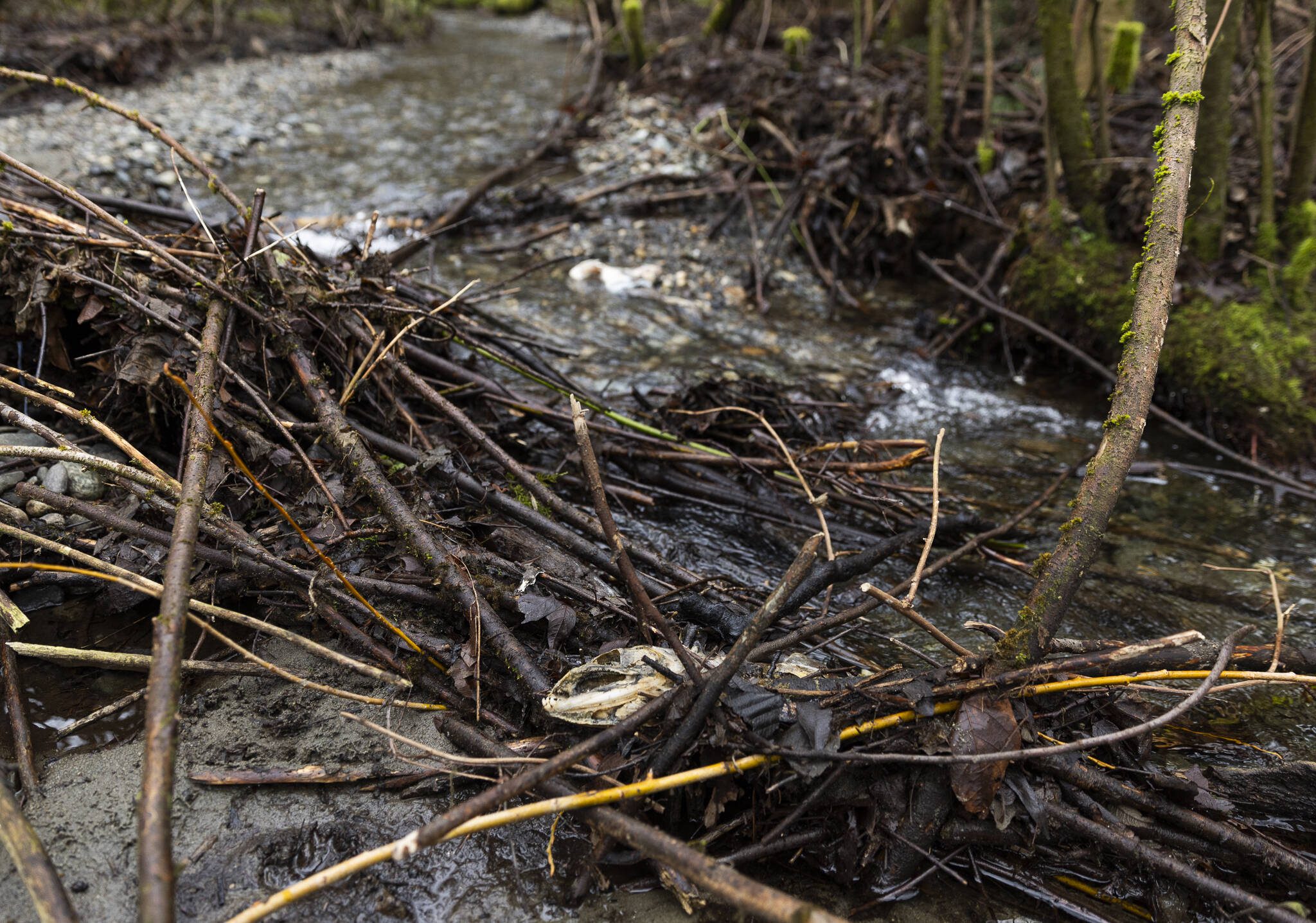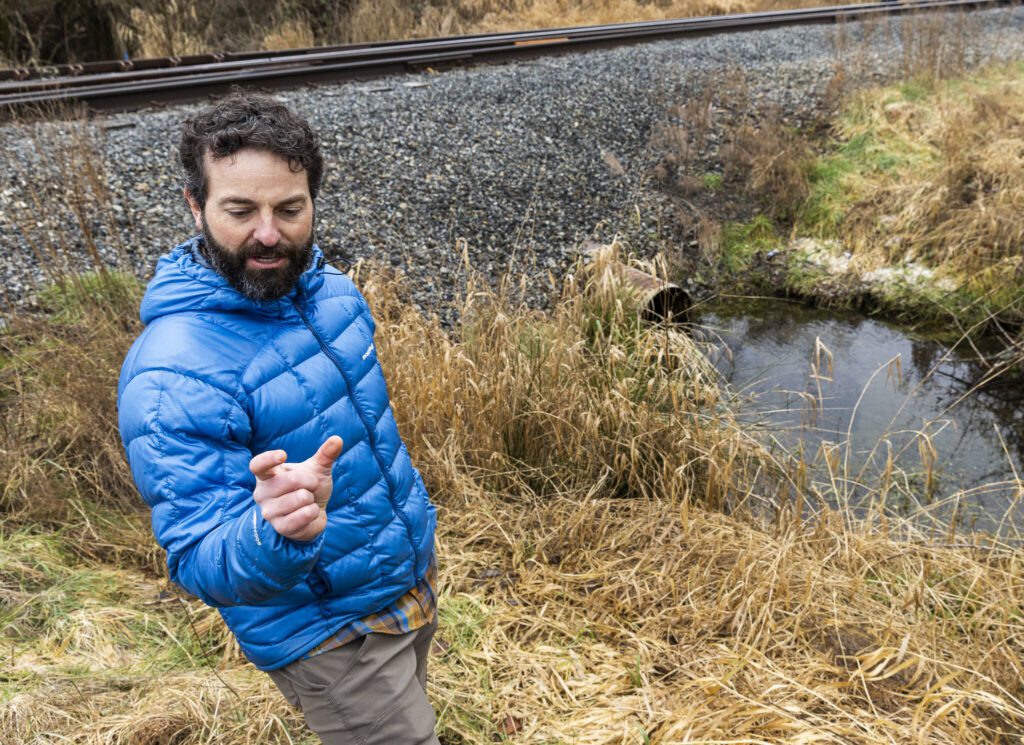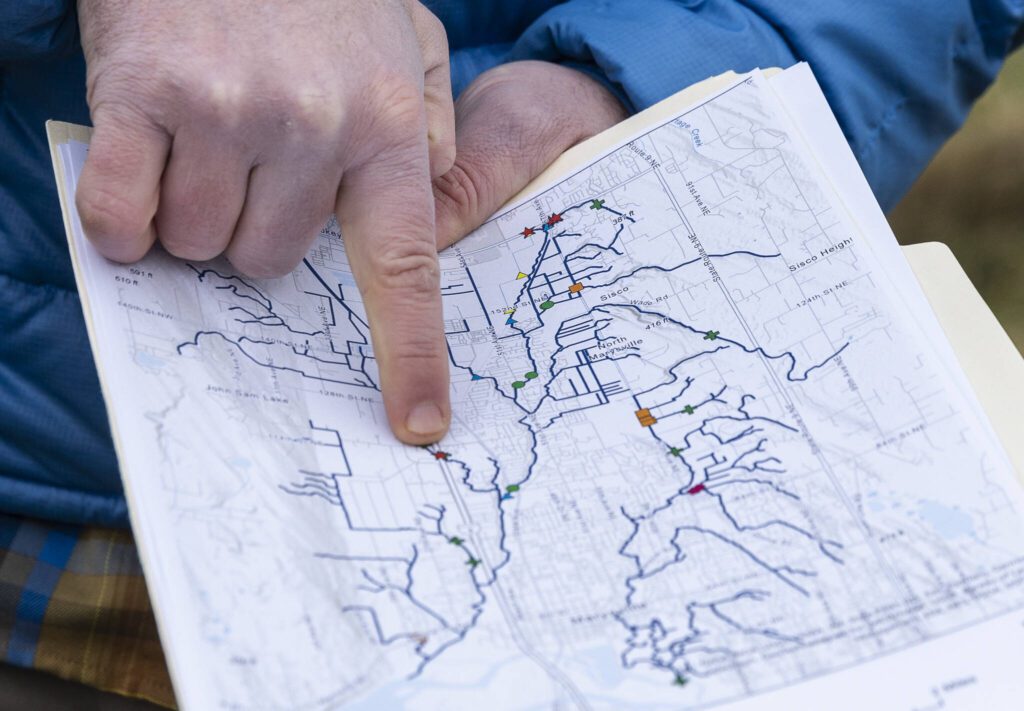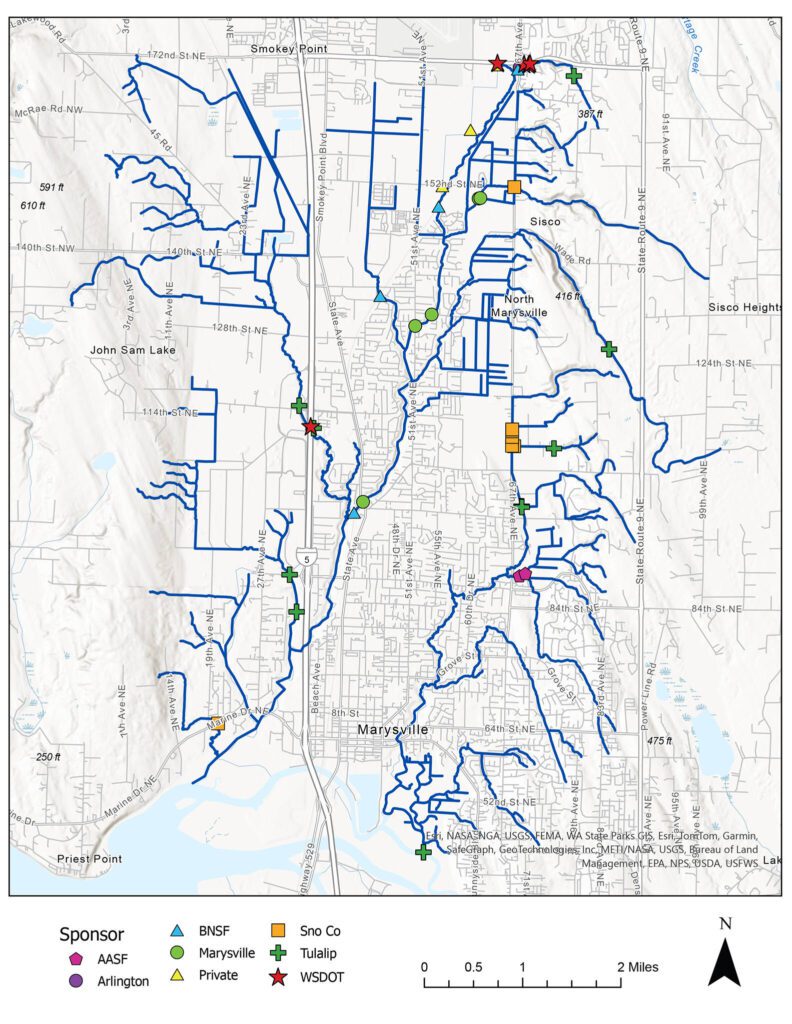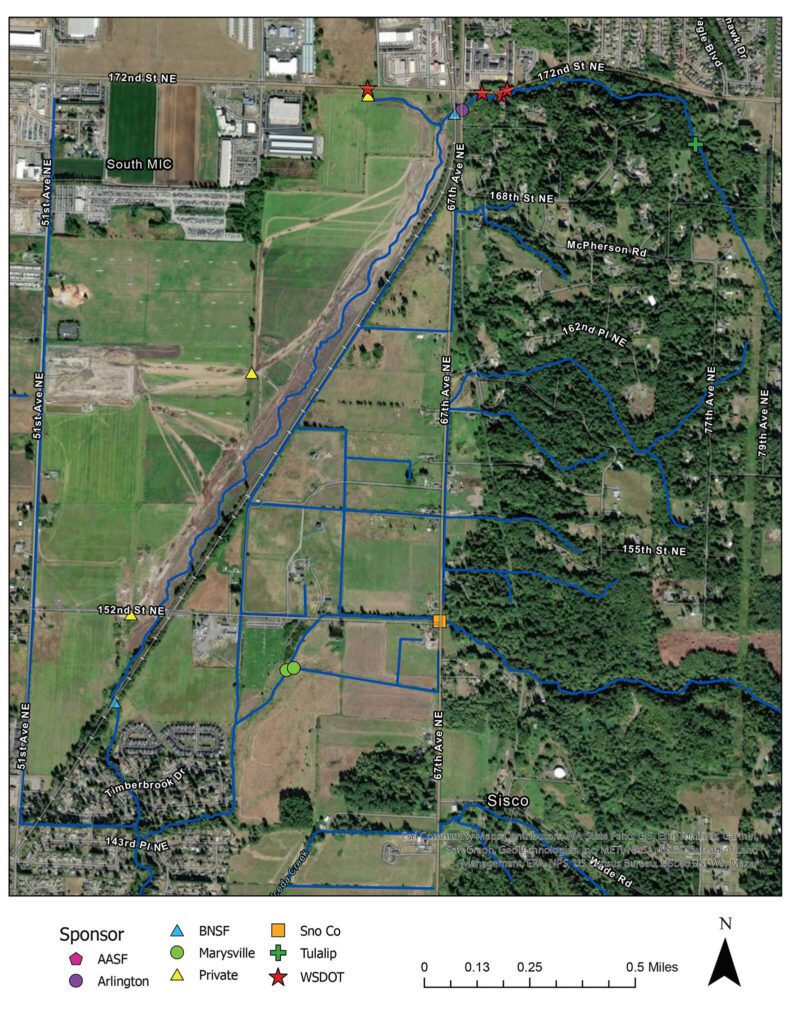ARLINGTON — Hindered by habitat degradation, overfishing and pollution, salmon populations along the West Coast have been in decline for decades. Even if a salmon makes it to adulthood, surviving a migration from river to sea, enduring years in the open ocean and persevering on its journey back to spawning grounds, the next generation might be decimated by unmaintained drain pipes and poorly designed culverts.
Washington’s Department of Transportation created a designated fish passage program in 1991 to improve the chances of survival for salmon, but a 2013 federal court order forced the state to ramp up its efforts. Critics worry about the expense and effectiveness of the projects, but local tribes say the obligated investment will pay off by catalyzing expansive salmon restoration work.
When colonizers came to the Washington territory in the mid-1800s, they forced tribes onto reservations. In western Washington particularly, these reservations are often fractions of traditional lands tribes inhabited.
Isaac Stevens, the state’s first governor and superintendent of Indian Affairs of the Washington Territory, negotiated eight treaties in the mid-1800s, promising the tribes exclusive rights of land in the designated reservations. The treaties also promised the tribal nations would continue to have the right to hunt, fish and gather outside the reservations.
In 2001, 21 tribes sued the state of Washington over its failure to follow treaty-based requirements to preserve fish populations. The tribes won, and in 2013 U.S. District Judge Ricardo Martinez ordered the state to fix or replace 1,000 culverts blocking access to 1,600 miles of salmon habitat.
The Washington State Department of Transportation has now been rushing to meet the 2030 deadline for amending high-priority barriers, spending $4 billion in the process and still needing billions more.
The total cost of these projects has drawn scrutiny from some government officials, fish biologists, media and tribal leaders because in a highly industrialized world, streams and rivers aren’t usually blocked by a single barrier, and the state doesn’t have jurisdiction over the many obstacles fish runs face.
But the Tulalip Tribes believe that, outside of the state’s obligation to honor treaty rights, the injunction has knocked down the heaviest, most complicated, most expensive projects, allowing local entities to piggyback off habitat restoration efforts.
A section of Edgecomb Creek in Arlington near the intersection of 172nd Street Northeast and 67th Avenue Northeast is a prime example of coordinated collaboration that’s come out of the state’s injunction.
Before the state started its work on the stream, Edgecomb Creek crisscrossed back and forth under a section of Highway 531 and, as a result, was virtuously impassable for fish, according to the tribes.
But in 2017, WSDOT bought out a property next to the highway, took down a house and rerouted the creek to stay south of the road.
Then the state put in a 16-by-6-foot box culvert under another house’s nearby driveway, linking the rerouted stretch of the creek as it continues east.
The Edgecomb Creek project cost $3 million, a drop in the almost $4 billion bucket the state has committed to projects. To meet the injunction’s obligation of opening 90% of identified barriers, WSDOT has asked the Legislature for $5 billion more.
An investigation by the Seattle Times last year examined the high price of removing salmon barriers.
“For every barrier WSDOT fixes, nine others upstream and two downstream partially or fully block fish migration,” the newspaper’s analysis found.
The investigation published in March highlighted projects such as the Duffner Ditch in Whatcom County, where the state replaced two barriers for $4.5 million, even though experts said the stream, which runs through agricultural fields and is full of invasive weeds, was poor salmon habitat.
There are some bad projects on the state’s injunction list, Brett Shattuck, senior scientist of Restoration, Acquisition and Stewardship for the Tulalip Tribes said, but the tribes and other partners have worked hard to remove those projects from the required list or at least lower their priority.
“It’s not only us asking the state to do stuff, the state also comes and asks us, ‘Is this crossing really fish habitat?’” he said. “The tribe has, with our collaboration, really saved the state many, many millions of dollars, because we can come in and we are willing to make reasonable judgments in favor of [the state] to help them save money.”
Shattuck also argues that state projects are essential linchpins for large-scale watershed restoration because it was hard for local entities to prioritize projects that would be useless without the expensive and expansive work done by the state on complicated or large barriers.
“Once we see the state is now investing in these streams, we can look up and downstream and look at what infrastructure is up and downstream of those crossings, and then build upon the successes that the state has made by engaging counties, cities, private entities, NGOs, homeowners,” he said.
Right across 67th Avenue NE where the state rerouted Edgecomb Creek, an open lot sits adjacent to Highway 531. NorthPoint Development owns the lot, and in the future, will develop the west side of the property.
But as compensatory mitigation for the future development, NorthPoint funded restoration along 2 miles of Edgecomb Creek that runs through the east side of the lot, extending off where the state restored access along Highway 531.
The creek used to flow through what were essentially drainage ditches, with no native vegetation or pools, Tulalip Tribes’ Timber, Fish and Wildlife manager Derek Marks said.
“Sediment in the ditch was essentially just what was dug up in the fields— that’s difficult for fish to use for complete life cycles,” he said.
NorthPoint reached out to the Tulalip Tribes for input on restoration, and a few years later, the lot has transformed.
The 2-mile stretch of creek now runs diagonally through the field, with variations of gravel and sediment lining the stream bed. Tree saplings grow along the banks and grasses bend over the water.
A few salmon carcasses lay partially exposed on the rocks, decaying proof of full-grown fish making it to the stream to mate and lay eggs.
NorthPoint’s restoration was just the beginning of the Tulalip Tribes’ collaborative efforts to enhance the area for fish.
The state’s culvert project and the NorthPoint restoration area are separated by 67th Avenue NE and a BNSF railway. A pipe runs under the road, and while some fish can get through it, the tribes’ scientists said it could be much better.
On the east end, gravel and debris have cut off access to much of the pipe. On the west end, the pipe is relatively small in diameter, meaning when water levels are high the pipe acts like a hose, shooting water out at a velocity fish can’t overpower if they’re trying to swim up the current.
The Tulalip Tribes have partnered with Burlington Northern Santa Fe to rework the railroad tracks for better fish passage. The railway company will take out the gravel currently supporting the tracks, and replace it with bridges, allowing a much broader swath of stream to pass underneath.
The Tulalip Tribes and BNSF are also working to identify and restore fish barriers along the railroads running right along Puget Sound, which are often the first barriers fish meet when trying to migrate upstream.
“The relationship between BNSF Railway and the Tulalip Tribes exemplifies how collaborations can drive meaningful environmental restoration,” BNSF director of engineering services Jeff Swanson wrote in a statement. “By working together to remove fish passage barriers, we’re not only restoring critical habitat for native fish species but also honoring the Tribe’s deep connection to these waters. It is a shared commitment to sustainability, cultural respect, and ecological stewardship.”
Within a few-mile radius at the intersection of Highway 531 and 67th Avenue NE where the state worked on Edgecomb Creek, nine other fish passage projects involving private landowners, Snohomish County, the city of Arlington, the city of Marysville and BNSF are coming to fruition.
Edgecomb Creek is just one of the areas where the Tulalip Tribes have initiated and coordinated restoration projects. By leveraging the large price tags of the state’s projects, Shattuck has put together grant packages highlights partnerships between local governments, corporations and nonprofits like Adopt A Stream and Trout Unlimited.
The Tulalip Tribes have already received almost $32.8 million in funding, a majority of that coming from two National Oceanic and Atmospheric Administration grants. They have applied for another $44.7 million in grants and are waiting to hear about securement.
Coordinating between the county, cities, nonprofits, companies and private landowners takes a lot of effort and time, and the Tulalip Tribes have championed the effort for the Snohomish and Stillaguamish watersheds, Shattuck said.
“The tribes took leadership in saying, ‘Hey, these crossings need to be fixed. If the state won’t do it, we’re going to have to fight for treaty-retained rights,’” he said. “Now that that’s been affirmed in the courts, we want to do it [in] the most efficient and effective way possible, by working with partners.”
Other tribes and partners have also built on the department of transportation’s fish passage work.
In Whatcom County, the Nooksack Tribe’s Regional Fisheries Enhancement Group worked on a barrier downstream of a state I-5 project in the Silver Creek watershed. The Lummi Nation is partnering with BNSF to address the lowest barrier in the watershed, and the city of Bellingham is expanding fish passage projects along Padden Creek and Squalicum Creek.
“The WSDOT I-5 projects are the most expensive projects in the watershed and, without them taking the lead, it is unlikely that these other projects would be moving forward,” The Nooksack Tribal Council and Nooksack Natural Resources wrote in a statement.
Like the Tulalip Tribes, the Nooksack Tribe and Lummi Nation have applied for passage restoration funding to support their partners’ work under various jurisdictions.
The Tulalip Tribes acknowledge that not all the barriers identified in the injunction are great opportunities for restoration, but they want Washingtonians to understand the state’s work isn’t being done in a vacuum, and the projects aren’t a waste of money in their eyes.
“The state wasted money years ago building infrastructure that wasn’t resilient and didn’t take into account the resources that are shared in common with the tribes who have a legal right to it,” Marks said. “It’s unfortunate that we got to this place where we have so much infrastructure in the landscape that was built with some faulty premises, but that’s where we’re at.”
Eliza Aronson: 425-339-3434; eliza.aronson@heraldnet.com; X: @ElizaAronson.
Eliza’s stories are supported by the Herald’s Environmental and Climate Reporting Fund.
Talk to us
> Give us your news tips.
> Send us a letter to the editor.
> More Herald contact information.
